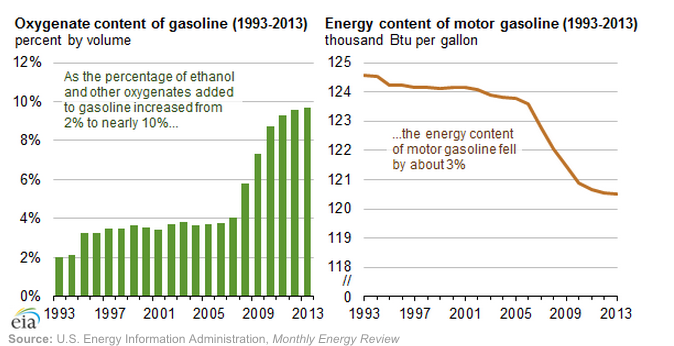“EIA has adjusted its estimates of the energy content of retail motor gasoline in the Monthly Energy Review (MER) to reflect its changing composition. Ethanol and other oxygenates, which have lower energy content than petroleum-based gasoline components, have seen their share of total gasoline volumes increase from 2% in 1993 to nearly 10% in 2013. As a result, EIA’s estimate of motor gasoline’s average energy content per gallon has declined by about 3% over this 20-year period,” writes the Energy Information Administration (EIA) in its latest Monthly Energy Review.
To better understand the changes, a recent “Today in Energy” looked at how higher U.S. ethanol use has cut the average energy content of a gallon of gasoline.
The EIA explains that the adjustment of the average energy content per gallon of motor gasoline reflects changes in response to 1990 Clean Air Act (CAA) regulations that split the U.S. gasoline market into three segments: conventional, oxygenated, and reformulated. Oxygenated and reformulated gasoline was required to be blended with compounds that contained oxygen, such as MTBE (methyl tert-butyl ether) or ethanol. This Act was designed to reduce toxic air emissions in cities and it was successful. However, EIA states that while these additives reduced air pollution, they also resulted in lower heating value compared with conventional gasoline, translating to fewer miles per gallon, because they have lower energy density.
In response to these regulations, EIA began collecting separate data on the production of conventional, oxygenated, and reformulated gasoline in 1994. The gasoline heating value was estimated based on the relative volumes of conventional, oxygenated, and reformulated gasoline in the total motor gasoline product supplied to the United States.
Also in 1994, EIA began to collect data on the amounts of ethanol, MTBE, and other oxygenates used to produce gasoline. The average energy content can be calculated as the total energy input of ethanol, MTBE (through April 2006, when refiners stopped using MTBE in domestic gasoline), other oxygenates (through the end of 2006, when other oxygenates were phased out), and gasoline blendstocks divided by the number of barrels supplied to the domestic market. The volume of hydrocarbon gasoline blendstocks is obtained by backing out ethanol, MTBE, and other oxygenates as applicable from the total motor gasoline supply to the United States.
Ultimately, the EIA found that over the past 20 years, gasoline’s average energy content per gallon has declined by about 3 percent. This accounts for the use of mid-level and higher blends of ethanol. The EIA said they will continue to measure energy content in gasoline and continue to capture changes.


